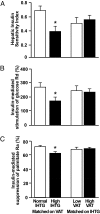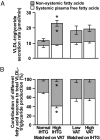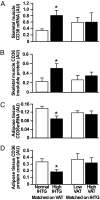Intrahepatic fat, not visceral fat, is linked with metabolic complications of obesity
- PMID: 19706383
- PMCID: PMC2741268
- DOI: 10.1073/pnas.0904944106
Intrahepatic fat, not visceral fat, is linked with metabolic complications of obesity
Abstract
Visceral adipose tissue (VAT) is an important risk factor for obesity-related metabolic disorders. Therefore, a reduction in VAT has become a key goal in obesity management. However, VAT is correlated with intrahepatic triglyceride (IHTG) content, so it is possible that IHTG, not VAT, is a better marker of metabolic disease. We determined the independent association of IHTG and VAT to metabolic function, by evaluating groups of obese subjects, who differed in IHTG content (high or normal) but matched on VAT volume or differed in VAT volume (high or low) but matched on IHTG content. Stable isotope tracer techniques and the euglycemic-hyperinsulinemic clamp procedure were used to assess insulin sensitivity and very-low-density lipoprotein-triglyceride (VLDL-TG) secretion rate. Tissue biopsies were obtained to evaluate cellular factors involved in ectopic triglyceride accumulation. Hepatic, adipose tissue and muscle insulin sensitivity were 41, 13, and 36% lower (P < 0.01), whereas VLDL-triglyceride secretion rate was almost double (P < 0.001), in subjects with higher than normal IHTG content, matched on VAT. No differences in insulin sensitivity or VLDL-TG secretion were observed between subjects with different VAT volumes, matched on IHTG content. Adipose tissue CD36 expression was lower (P < 0.05), whereas skeletal muscle CD36 expression was higher (P < 0.05), in subjects with higher than normal IHTG. These data demonstrate that IHTG, not VAT, is a better marker of the metabolic derangements associated with obesity. Furthermore, alterations in tissue fatty acid transport could be involved in the pathogenesis of ectopic triglyceride accumulation by redirecting plasma fatty acid uptake from adipose tissue toward other tissues.
Conflict of interest statement
Conflict of interest: The authors declare no conflict of interest.
Figures



Comment in
-
Nonalcoholic fatty liver disease: the hepatic trigger of the metabolic syndrome.J Hepatol. 2010 Dec;53(6):1146-7. doi: 10.1016/j.jhep.2010.06.013. Epub 2010 Aug 13. J Hepatol. 2010. PMID: 20817302 No abstract available.
Similar articles
-
Visceral adipose tissue tracks more closely with metabolic dysfunction than intrahepatic triglyceride in lean Asians without diabetes.J Appl Physiol (1985). 2018 Sep 1;125(3):909-915. doi: 10.1152/japplphysiol.00250.2018. Epub 2018 May 10. J Appl Physiol (1985). 2018. PMID: 29745794
-
Effect of fenofibrate and niacin on intrahepatic triglyceride content, very low-density lipoprotein kinetics, and insulin action in obese subjects with nonalcoholic fatty liver disease.J Clin Endocrinol Metab. 2010 Jun;95(6):2727-35. doi: 10.1210/jc.2009-2622. Epub 2010 Apr 6. J Clin Endocrinol Metab. 2010. PMID: 20371660 Free PMC article. Clinical Trial.
-
Alterations in adipose tissue and hepatic lipid kinetics in obese men and women with nonalcoholic fatty liver disease.Gastroenterology. 2008 Feb;134(2):424-31. doi: 10.1053/j.gastro.2007.11.038. Epub 2007 Nov 28. Gastroenterology. 2008. PMID: 18242210 Free PMC article.
-
Visceral adiposity and inflammatory bowel disease.Int J Colorectal Dis. 2021 Nov;36(11):2305-2319. doi: 10.1007/s00384-021-03968-w. Epub 2021 Jun 9. Int J Colorectal Dis. 2021. PMID: 34104989 Review.
-
Intrahepatic triglyceride content: influence of metabolic and genetics drivers.Curr Opin Clin Nutr Metab Care. 2022 Jul 1;25(4):241-247. doi: 10.1097/MCO.0000000000000838. Curr Opin Clin Nutr Metab Care. 2022. PMID: 35762159 Review.
Cited by
-
Metabolic surgery for type 2 diabetes with BMI <35 kg/m(2) : an endocrinologist's perspective.Obes Surg. 2013 Jun;23(6):800-8. doi: 10.1007/s11695-013-0907-1. Obes Surg. 2013. PMID: 23515973 Free PMC article. Review.
-
Review of Metabolic Surgery for Type 2 Diabetes in Patients with a BMI < 35 kg/m(2).J Obes. 2012;2012:147256. doi: 10.1155/2012/147256. Epub 2012 Jun 5. J Obes. 2012. PMID: 22720136 Free PMC article.
-
Physical activity is inversely associated with hepatic fibro-inflammation: A population-based cohort study using UK Biobank data.JHEP Rep. 2022 Nov 2;5(1):100622. doi: 10.1016/j.jhepr.2022.100622. eCollection 2023 Jan. JHEP Rep. 2022. PMID: 36440257 Free PMC article.
-
PCOS is associated with increased CD11c expression and crown-like structures in adipose tissue and increased central abdominal fat depots independent of obesity.J Clin Endocrinol Metab. 2013 Jan;98(1):E17-24. doi: 10.1210/jc.2012-2697. Epub 2012 Nov 1. J Clin Endocrinol Metab. 2013. PMID: 23118428 Free PMC article.
-
Natural flavonoids: Potential therapeutic strategies for non-alcoholic fatty liver disease.Front Pharmacol. 2022 Sep 16;13:1005312. doi: 10.3389/fphar.2022.1005312. eCollection 2022. Front Pharmacol. 2022. PMID: 36188561 Free PMC article. Review.
References
-
- Gastaldelli A, et al. Metabolic effects of visceral fat accumulation in type 2 diabetes. J Clin Endocrinol Metab. 2002;87:5098–5103. - PubMed
-
- Vega GL, et al. Influence of body fat content and distribution on variation in metabolic risk. J Clin Endocrinol Metab. 2006;91:4459–4466. - PubMed
-
- Adiels M, et al. Overproduction of large VLDL particles is driven by increased liver fat content in man. Diabetologia. 2006;49:755–765. - PubMed
-
- Despres JP. The insulin resistance-dyslipidemic syndrome of visceral obesity: Effect on patients' risk. Obes Res. 1998;6(Suppl 1):8S–17S. - PubMed
-
- Bergman RN, et al. Why visceral fat is bad: Mechanisms of the metabolic syndrome. Obesity (Silver Spring) 2006;14(Suppl 1):16S–19S. - PubMed
Publication types
MeSH terms
Substances
Grants and funding
- R01 DK060022/DK/NIDDK NIH HHS/United States
- P30 DK056341/DK/NIDDK NIH HHS/United States
- UL1 RR024992/RR/NCRR NIH HHS/United States
- R01 DK033301/DK/NIDDK NIH HHS/United States
- UL1 TR000448/TR/NCATS NIH HHS/United States
- DK33301/DK/NIDDK NIH HHS/United States
- R01 DK037948/DK/NIDDK NIH HHS/United States
- P30 DK056341-09/DK/NIDDK NIH HHS/United States
- DK 37948/DK/NIDDK NIH HHS/United States
- P30 DK056341-08/DK/NIDDK NIH HHS/United States
- DK60022/DK/NIDDK NIH HHS/United States
- RR-00954/RR/NCRR NIH HHS/United States
- DK 56341/DK/NIDDK NIH HHS/United States
- P41 RR000954/RR/NCRR NIH HHS/United States
LinkOut - more resources
Full Text Sources
Other Literature Sources
Medical
Miscellaneous

